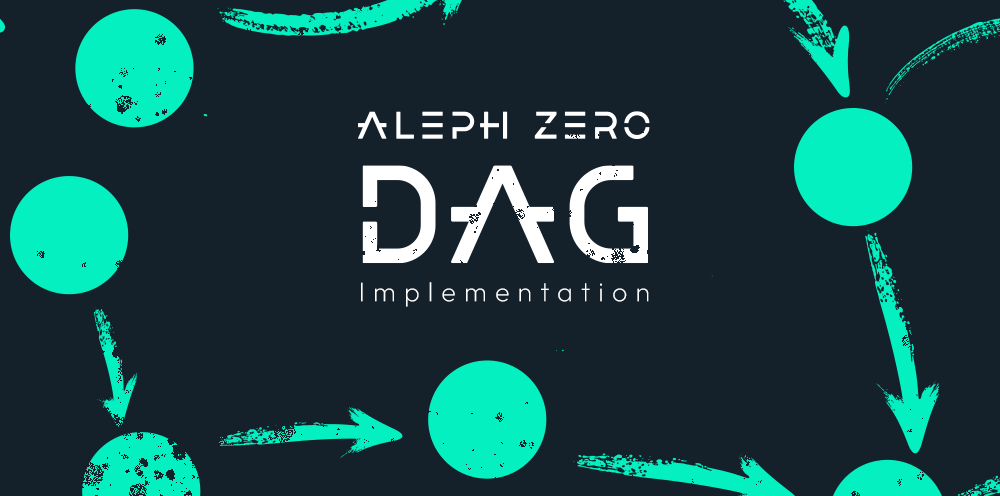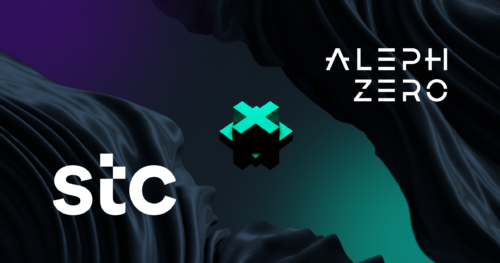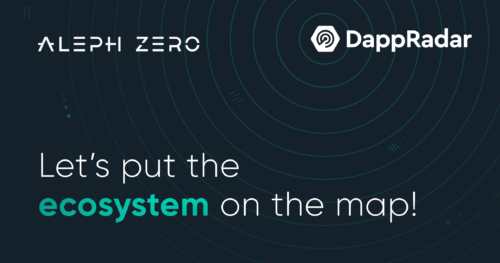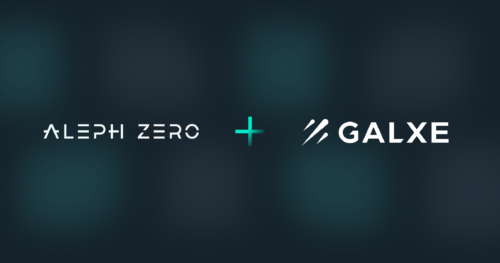Fundamentals: Aleph Zero and its DAG Implementation
Dec 13, 2021

The beating heart of every blockchain is its consensus protocol. Aleph Zero employs a custom-built Proof-of-Stake concept that ensures unprecedented levels of decentralization and security.
But how does it actually work, you may be asking yourself, and truth be told, that is a question worth answering. In this series, called Fundamentals, we’ll be going into the nuts and bolts of the Aleph Zero blockchain. We will offer some detailed explanations of what it is that we are precisely doing. First off will be a dive into our consensus protocol. Consensus protocols define how decentralized ledgers decide on a single version of the truth. There are two dominant paradigms used by consensus protocols: Proof-of-Work (PoW) and Proof-of-Stake (PoS).
Proof-of-Work vs. Proof-of-Stake
PoW protocols are hardware-based solutions associated most strongly with legacy blockchains such as Bitcoin. Through this method, users who possess the appropriate hardware can validate transactions conducted on the network. They do this by solving cryptographic puzzles that, once completed, confirm the truthfulness of the transactions. This results in the adding of a new block to the blockchain. In this model, only one node can be responsible for the creation of a block and, in turn, receive the reward for successfully tending to the truthfulness of the chain. Once confirmed as true, the newly modified blockchain is stored on all nodes in the network.

PoS protocols are a more recent development and seek to solve some of the issues involved with PoW consensus methods. PoS differs from PoW because it is not reliant on nodes conducting complex cryptographic puzzles. Instead, they rely on users staking the appropriate number of tokens. The number of tokens varies among blockchains; for example, to become a validator on the Ethereum 2.0 chain, one must stake a minimum of 32ETH. Of course, the more coins you stake, the more valuable your voice in the protocol’s decision-making process. Once staked, the validator takes part in the governance process and decides along with other validators on the truthfulness of transactions conducted on-chain. If validators are corrupt and perform in a way that is damaging for the chain, they will face consequences that come in the form of slashing. This process results in confiscating the funds they staked.
Why move from PoW to PoS?
PoW is a controversial method for attaining consensus for several reasons. Firstly, it is highly dependent on energy, making it inefficient and ecologically damaging. Secondly, the number of transactions it can handle per second is relatively low, meaning that at most, it can be a niche solution with no chance at mass adoption. For example, Bitcoin can conduct a maximum of 4.6 transactions per second. This falls dramatically short of the 1,700 transactions per second that Visa operates, allowing for mainstream user adoption. Adopting a PoS mechanism can allow for greater transaction speeds and provides blockchain technology the ability to dynamically scale depending on market demand.
Also, at its core, PoW, to a greater extent than PoS, favors those with capital, as the technology required for mining is costly. Proof of this shortcoming is that most Bitcoin mining is in the hands of a handful of powerful entities responsible for validating the lion’s share of transactions. Through adopting PoS mechanisms, distributed ledgers can become fertile ground for creating even more decentralized communities.
Aleph Zero is Merging PoS with Directed Acyclic Graphs
Aleph Zero takes advantage of a heavily modified variation of the PoS consensus methodology in conjunction with Directed Acyclic Graphs (DAG). At its core, Aleph Zero employs a PoS consensus algorithm in which a rotating committee of validators decides on the truthfulness of the state of the blockchain. This makes it similar enough to other blockchains employing PoS methodologies. So why does Aleph Zero use a DAG?
Aleph Zero employs a Directed Acyclic Graph (DAG) as an intermediary in the creation of its blockchain. DAGs are primarily associated with the world of mathematics and computer science but have recently made waves in the blockchain industry. From a technical standpoint, using DAGs allows for faster transaction speeds and higher throughput and hence significantly lower transaction fees. Mining is a costly process, resulting in PoW algorithms generating high transfer costs. This is one of the advantages of DAGs. The low cost of the technology makes it feasible for mass adoption.
On the Order of Things
One of the biggest obstacles towards scaling blockchains is effectively ordering the transactions conducted on the network. The process of properly ordering transactions is essential to prevent double-spending and other malevolent practices. By taking advantage of DAGs, we can eliminate the threat of malicious block producers and create truly leaderless protocols.
The chain itself forms afterward. This results in the creation of two structures simultaneously. The DAG is an auxiliary structure that collects information on the order of transactions. The chain itself is constructed from the collected data. Validators propose blocks for the chain, always building on the highest correct blocks known to them. The DAG impacts the construction of the chain, yet is not the chain itself with the blocks finalized using DAG as an auxiliary structure in the parallel process.

One of the challenges facing DAG solutions is their purported lack of decentralization. In fact, this problem doesn’t concern DAG-based protocols any more than any other PoS systems; it just happened so that the early DAG-based solutions found their first application in a permissioned setting. The Aleph Zero development team has laid this claim to rest by ensuring a new standard of decentralization for DAGs. How did they manage to achieve this? To guarantee our protocol remains decentralized, we have adopted a mechanism that appoints a rotating committee of random members to decide on the future of the network. Conservative figures for this committee start at 128 nodes, but we will be aiming for much higher numbers to spread out the network as much as possible.
AlephBFT and its Properties
The second crucial ingredient of our consensus protocol is the Byzantine Fault Tolerance (BFT) architecture we employ. Through the use of BFT, we can ensure that the communication between nodes remains effective and transparent despite the presence of malicious nodes. BFT consensus models suppose that less than ⅓ of the nodes within a network are acting in bad faith. If we assume ⅔ of the users are honest, a BFT blockchain can operate securely while ensuring an immutable and proven history of transactions.
One of the criticisms directed towards BFT solutions is their perceived ineffectiveness beyond permissioned settings. We have faced this challenge through the introduction of rotating committees. Additional security is guaranteed by employing the element of asynchronicity. This means that the network will work smoothly and retain data correctness even if some parts of the network are down. Implementing asynchronous properties to BFT is a step forward to ensure maximum security. This benefits enterprise users as well as open-source projects like Aleph Zero.
Industry Adoption of BFT Solutions
As you read this article, the blockchain space is seeing a wider adoption of BFT solutions. This includes Polkadot’s very own GRANDPA/BABE solution as well as the Casper Highway Protocol.
- In Polkadot’s case, their BFT proposal works as a partially synchronous network model when ⅔ of the nodes are honest and can manage ⅕ Byzantine nodes in an asynchronous setting. They can expedite the finalization process by reaching a consensus on chains and not on individual blocks.
- The Casper Network prides itself on higher levels of finality and flexibility than other BFT protocols currently on the market. One aspect of their unique take on BFT is incentivizing honest behavior by offering higher finality when more nodes behave honestly. To maintain flexibility, individual nodes can decide on their finality threshold. This means that nodes can play different roles in the ecosystem. A node can require higher finality for transactions that are larger, while less essential transactions can have a lower threshold.
Defending the DAG
Malicious nodes and users operating in bad faith will always be present, no matter how secure a consensus protocol is. In this sense, the blockchain space mirrors the real world with the caveat that blockchain technology offers unmatched security solutions. It is important to discuss the “nuclear options” a blockchain has at its disposal when dealing with malicious nodes or nodes that draw suspicion of acting against the interest of honest users. Aleph Zero distinguishes itself in this respect by committing itself to the idea of freezing funds rather than slashing them in the case of suspected malpractice.
As with most PoS protocols, there are certain dangers we must consider that may arise from users with less than pure intentions. Most PoS protocols employ slashing as a potential punishment for corrupt behavior. Slashing involves confiscating the funds allocated by an individual to take part in the staking mechanism. This is a shortsighted practice that can result in unnecessary accusations and financial loss. Often, the accused are the victims of errors in the protocol and receive punishment for occurrences beyond their control.
To limit this kind of abuse, Aleph Zero’s on-chain governance mechanism (which the team aims to implement as soon as possible) might employ a freezing mechanism instead. Freezing funds would involve the temporary suspension of capital staked by the suspected user. Firstly, an investigation on whether an internal error occurred or whether the user had malicious intentions would have to occur. This case-by-case approach is a significantly fairer approach to the matter than indiscriminate slashing.
Aleph Zero: The Peer-Reviewed Blockchain
In this article, we went over some of the innovations and unique selling points that make Aleph Zero such an interesting project in the blockchain space. Nobody likes a braggart, so don’t take our word for it! Aleph Zero has been peer-reviewed by the AFT (Advances in Financial Technologies) and is dedicated to maintaining the highest standards of scientific research. Our unique take on DAGs, BFT, while employing zero-knowledge proofs alongside secure multi-party computations have put us on the road to creating a scalable, secure, and most importantly private blockchain that puts the user first while being also ideal for enterprise use-cases.


